Impact of NSCLC on Nigel's Breathing Difficulty and Liver Metastasis
VerifiedAdded on 2022/12/26
|11
|4721
|58
AI Summary
This article discusses the impact of non-small cell lung cancer (NSCLC) on Nigel's breathing difficulty and liver metastasis. It explores the different types of NSCLC and their characteristics. The article also examines the role of chemotherapy medications in managing NSCLC and their effects on hepatic first-pass metabolism. The importance of early detection and the risk of comorbidities are also discussed.
Contribute Materials
Your contribution can guide someone’s learning journey. Share your
documents today.

P a g e | 1
Q1 ... (answer)
Non-small cell lung cancer (NSCLC) is associated with the abnormal differentiation
of lung cancer cells that accumulate across the lungs and exhibit the tendency to spread to
other body parts (Zappa & Mousa 2016). Most of the lung cancer cases comprise of NSCLC
and subjected to chemotherapy for treatment. Various types of NSCLC include
adenocarcinoma, squamous cell carcinoma, and large cell carcinoma. Adenocarcinoma
impact outer pulmonary regions and develops at a slow pace. The early detection of this lung
cancer type makes it unique from other NSCLC types (Zappa & Mousa 2016). However,
squamous cell carcinoma impacts the inner pulmonary airways through the development of
flat-cells. Large cell carcinoma spontaneously invades any pulmonary region at a greater pace
and usually diagnosed at an advanced stage. Nigel in the presented case appears to be
affected with large cell carcinoma based on metastasis and rapid spread of the cancer cells
across the pulmonary regions (Zappa & Mousa 2016). Breathing difficulty proves to be the
preliminary clinical manifestation in NSCLC patients. Nigel’s breathing difficulty in the
presented case could have emanated from various NSCLC complications including flu, cold,
pneumonia, stress, anxiety, fatigue, medication, or anaemia (Mulvihill 2018). Dyspnoea is a
commonly reported finding in NSCLC and reportedly occurs under the sustained impact of
pulmonary airflow obstruction (Ban et al. 2016). Breathing difficulty in Nigel’s case is
indicative of pulmonary system deterioration and substantially elevates his risk for mortality
and other life-threatening pathophysiological complications (Zappa & Mousa 2016).
Dyspnoea substantially elevates the physiological stress of the patients affected with NSCLC
(non-small cell lung cancer) (Shin et al. 2014). The undifferentiated NSCLC cells
spontaneously metastasise to bronchi, pericardium, liver, diaphragm, and pleura of the
affected patient. Accordingly, NSCLC in the presented case impacted Nigel’s liver, thereby
leading to the development of secondary liver cancer. The NSCLC metastasis also facilitates
the transfer of cancer cells to the vertebral column, oesophagus, trachea, great vessels, and
mediastinum (Myers & Wallen 2019). Furthermore, the development of cancer cells across
contralateral lung drastically disrupts the total lung capacity, tidal volume, and overall
breathing potential. The NSCLC metastatic processes continue to deteriorate the normal
anatomical structures and physiological functioning of pericardium and pleura. The eventual
development of pericardial and pleural effusions leads to breathing difficulty or shortness of
breath in the affected patients (LCA 2019). Accordingly, Nigel’s incapacity to attain desired
air volume in the presented clinical scenario not only causes shortness of breath/breathing
Q1 ... (answer)
Non-small cell lung cancer (NSCLC) is associated with the abnormal differentiation
of lung cancer cells that accumulate across the lungs and exhibit the tendency to spread to
other body parts (Zappa & Mousa 2016). Most of the lung cancer cases comprise of NSCLC
and subjected to chemotherapy for treatment. Various types of NSCLC include
adenocarcinoma, squamous cell carcinoma, and large cell carcinoma. Adenocarcinoma
impact outer pulmonary regions and develops at a slow pace. The early detection of this lung
cancer type makes it unique from other NSCLC types (Zappa & Mousa 2016). However,
squamous cell carcinoma impacts the inner pulmonary airways through the development of
flat-cells. Large cell carcinoma spontaneously invades any pulmonary region at a greater pace
and usually diagnosed at an advanced stage. Nigel in the presented case appears to be
affected with large cell carcinoma based on metastasis and rapid spread of the cancer cells
across the pulmonary regions (Zappa & Mousa 2016). Breathing difficulty proves to be the
preliminary clinical manifestation in NSCLC patients. Nigel’s breathing difficulty in the
presented case could have emanated from various NSCLC complications including flu, cold,
pneumonia, stress, anxiety, fatigue, medication, or anaemia (Mulvihill 2018). Dyspnoea is a
commonly reported finding in NSCLC and reportedly occurs under the sustained impact of
pulmonary airflow obstruction (Ban et al. 2016). Breathing difficulty in Nigel’s case is
indicative of pulmonary system deterioration and substantially elevates his risk for mortality
and other life-threatening pathophysiological complications (Zappa & Mousa 2016).
Dyspnoea substantially elevates the physiological stress of the patients affected with NSCLC
(non-small cell lung cancer) (Shin et al. 2014). The undifferentiated NSCLC cells
spontaneously metastasise to bronchi, pericardium, liver, diaphragm, and pleura of the
affected patient. Accordingly, NSCLC in the presented case impacted Nigel’s liver, thereby
leading to the development of secondary liver cancer. The NSCLC metastasis also facilitates
the transfer of cancer cells to the vertebral column, oesophagus, trachea, great vessels, and
mediastinum (Myers & Wallen 2019). Furthermore, the development of cancer cells across
contralateral lung drastically disrupts the total lung capacity, tidal volume, and overall
breathing potential. The NSCLC metastatic processes continue to deteriorate the normal
anatomical structures and physiological functioning of pericardium and pleura. The eventual
development of pericardial and pleural effusions leads to breathing difficulty or shortness of
breath in the affected patients (LCA 2019). Accordingly, Nigel’s incapacity to attain desired
air volume in the presented clinical scenario not only causes shortness of breath/breathing
Secure Best Marks with AI Grader
Need help grading? Try our AI Grader for instant feedback on your assignments.
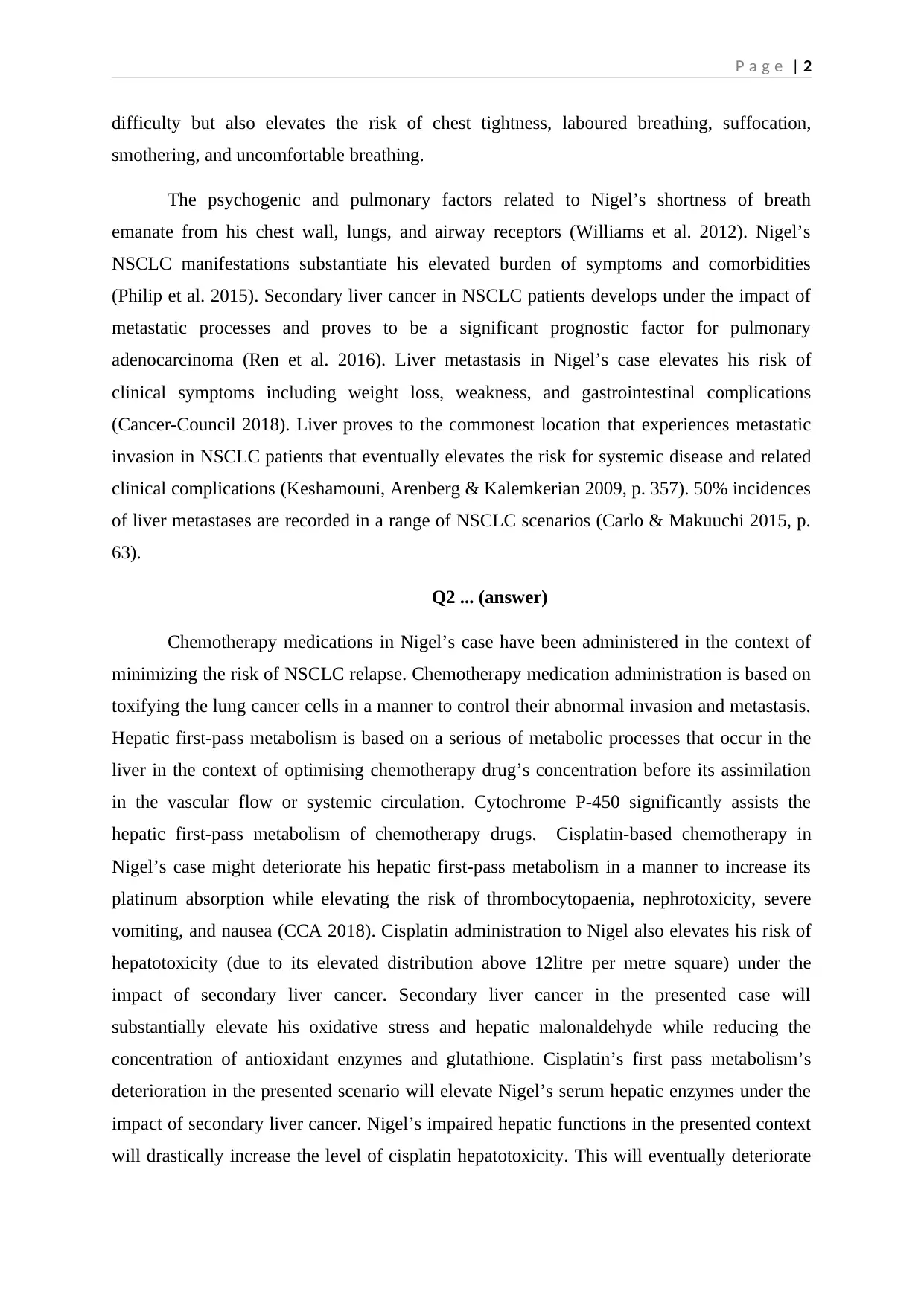
P a g e | 2
difficulty but also elevates the risk of chest tightness, laboured breathing, suffocation,
smothering, and uncomfortable breathing.
The psychogenic and pulmonary factors related to Nigel’s shortness of breath
emanate from his chest wall, lungs, and airway receptors (Williams et al. 2012). Nigel’s
NSCLC manifestations substantiate his elevated burden of symptoms and comorbidities
(Philip et al. 2015). Secondary liver cancer in NSCLC patients develops under the impact of
metastatic processes and proves to be a significant prognostic factor for pulmonary
adenocarcinoma (Ren et al. 2016). Liver metastasis in Nigel’s case elevates his risk of
clinical symptoms including weight loss, weakness, and gastrointestinal complications
(Cancer-Council 2018). Liver proves to the commonest location that experiences metastatic
invasion in NSCLC patients that eventually elevates the risk for systemic disease and related
clinical complications (Keshamouni, Arenberg & Kalemkerian 2009, p. 357). 50% incidences
of liver metastases are recorded in a range of NSCLC scenarios (Carlo & Makuuchi 2015, p.
63).
Q2 ... (answer)
Chemotherapy medications in Nigel’s case have been administered in the context of
minimizing the risk of NSCLC relapse. Chemotherapy medication administration is based on
toxifying the lung cancer cells in a manner to control their abnormal invasion and metastasis.
Hepatic first-pass metabolism is based on a serious of metabolic processes that occur in the
liver in the context of optimising chemotherapy drug’s concentration before its assimilation
in the vascular flow or systemic circulation. Cytochrome P-450 significantly assists the
hepatic first-pass metabolism of chemotherapy drugs. Cisplatin-based chemotherapy in
Nigel’s case might deteriorate his hepatic first-pass metabolism in a manner to increase its
platinum absorption while elevating the risk of thrombocytopaenia, nephrotoxicity, severe
vomiting, and nausea (CCA 2018). Cisplatin administration to Nigel also elevates his risk of
hepatotoxicity (due to its elevated distribution above 12litre per metre square) under the
impact of secondary liver cancer. Secondary liver cancer in the presented case will
substantially elevate his oxidative stress and hepatic malonaldehyde while reducing the
concentration of antioxidant enzymes and glutathione. Cisplatin’s first pass metabolism’s
deterioration in the presented scenario will elevate Nigel’s serum hepatic enzymes under the
impact of secondary liver cancer. Nigel’s impaired hepatic functions in the presented context
will drastically increase the level of cisplatin hepatotoxicity. This will eventually deteriorate
difficulty but also elevates the risk of chest tightness, laboured breathing, suffocation,
smothering, and uncomfortable breathing.
The psychogenic and pulmonary factors related to Nigel’s shortness of breath
emanate from his chest wall, lungs, and airway receptors (Williams et al. 2012). Nigel’s
NSCLC manifestations substantiate his elevated burden of symptoms and comorbidities
(Philip et al. 2015). Secondary liver cancer in NSCLC patients develops under the impact of
metastatic processes and proves to be a significant prognostic factor for pulmonary
adenocarcinoma (Ren et al. 2016). Liver metastasis in Nigel’s case elevates his risk of
clinical symptoms including weight loss, weakness, and gastrointestinal complications
(Cancer-Council 2018). Liver proves to the commonest location that experiences metastatic
invasion in NSCLC patients that eventually elevates the risk for systemic disease and related
clinical complications (Keshamouni, Arenberg & Kalemkerian 2009, p. 357). 50% incidences
of liver metastases are recorded in a range of NSCLC scenarios (Carlo & Makuuchi 2015, p.
63).
Q2 ... (answer)
Chemotherapy medications in Nigel’s case have been administered in the context of
minimizing the risk of NSCLC relapse. Chemotherapy medication administration is based on
toxifying the lung cancer cells in a manner to control their abnormal invasion and metastasis.
Hepatic first-pass metabolism is based on a serious of metabolic processes that occur in the
liver in the context of optimising chemotherapy drug’s concentration before its assimilation
in the vascular flow or systemic circulation. Cytochrome P-450 significantly assists the
hepatic first-pass metabolism of chemotherapy drugs. Cisplatin-based chemotherapy in
Nigel’s case might deteriorate his hepatic first-pass metabolism in a manner to increase its
platinum absorption while elevating the risk of thrombocytopaenia, nephrotoxicity, severe
vomiting, and nausea (CCA 2018). Cisplatin administration to Nigel also elevates his risk of
hepatotoxicity (due to its elevated distribution above 12litre per metre square) under the
impact of secondary liver cancer. Secondary liver cancer in the presented case will
substantially elevate his oxidative stress and hepatic malonaldehyde while reducing the
concentration of antioxidant enzymes and glutathione. Cisplatin’s first pass metabolism’s
deterioration in the presented scenario will elevate Nigel’s serum hepatic enzymes under the
impact of secondary liver cancer. Nigel’s impaired hepatic functions in the presented context
will drastically increase the level of cisplatin hepatotoxicity. This will eventually deteriorate
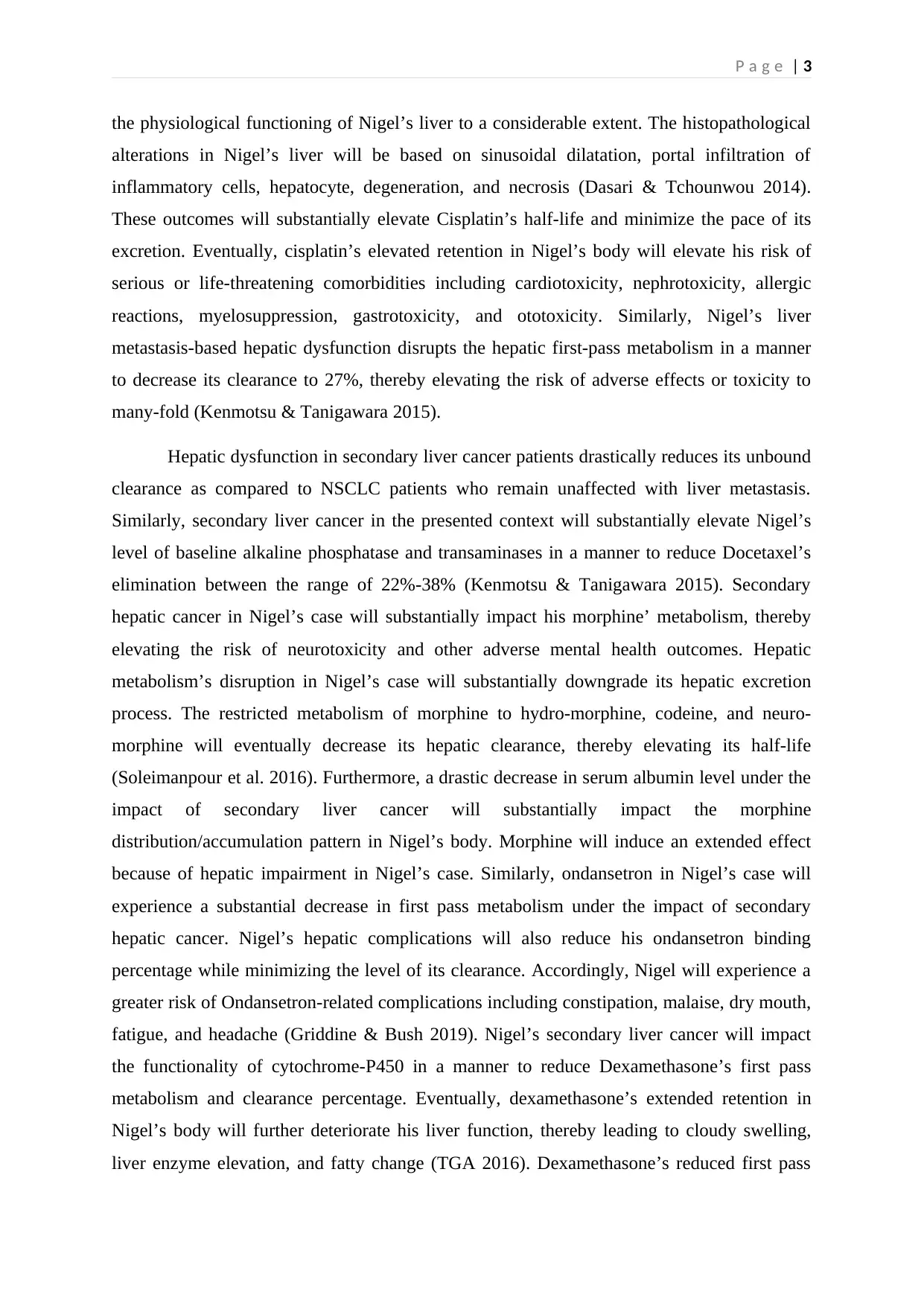
P a g e | 3
the physiological functioning of Nigel’s liver to a considerable extent. The histopathological
alterations in Nigel’s liver will be based on sinusoidal dilatation, portal infiltration of
inflammatory cells, hepatocyte, degeneration, and necrosis (Dasari & Tchounwou 2014).
These outcomes will substantially elevate Cisplatin’s half-life and minimize the pace of its
excretion. Eventually, cisplatin’s elevated retention in Nigel’s body will elevate his risk of
serious or life-threatening comorbidities including cardiotoxicity, nephrotoxicity, allergic
reactions, myelosuppression, gastrotoxicity, and ototoxicity. Similarly, Nigel’s liver
metastasis-based hepatic dysfunction disrupts the hepatic first-pass metabolism in a manner
to decrease its clearance to 27%, thereby elevating the risk of adverse effects or toxicity to
many-fold (Kenmotsu & Tanigawara 2015).
Hepatic dysfunction in secondary liver cancer patients drastically reduces its unbound
clearance as compared to NSCLC patients who remain unaffected with liver metastasis.
Similarly, secondary liver cancer in the presented context will substantially elevate Nigel’s
level of baseline alkaline phosphatase and transaminases in a manner to reduce Docetaxel’s
elimination between the range of 22%-38% (Kenmotsu & Tanigawara 2015). Secondary
hepatic cancer in Nigel’s case will substantially impact his morphine’ metabolism, thereby
elevating the risk of neurotoxicity and other adverse mental health outcomes. Hepatic
metabolism’s disruption in Nigel’s case will substantially downgrade its hepatic excretion
process. The restricted metabolism of morphine to hydro-morphine, codeine, and neuro-
morphine will eventually decrease its hepatic clearance, thereby elevating its half-life
(Soleimanpour et al. 2016). Furthermore, a drastic decrease in serum albumin level under the
impact of secondary liver cancer will substantially impact the morphine
distribution/accumulation pattern in Nigel’s body. Morphine will induce an extended effect
because of hepatic impairment in Nigel’s case. Similarly, ondansetron in Nigel’s case will
experience a substantial decrease in first pass metabolism under the impact of secondary
hepatic cancer. Nigel’s hepatic complications will also reduce his ondansetron binding
percentage while minimizing the level of its clearance. Accordingly, Nigel will experience a
greater risk of Ondansetron-related complications including constipation, malaise, dry mouth,
fatigue, and headache (Griddine & Bush 2019). Nigel’s secondary liver cancer will impact
the functionality of cytochrome-P450 in a manner to reduce Dexamethasone’s first pass
metabolism and clearance percentage. Eventually, dexamethasone’s extended retention in
Nigel’s body will further deteriorate his liver function, thereby leading to cloudy swelling,
liver enzyme elevation, and fatty change (TGA 2016). Dexamethasone’s reduced first pass
the physiological functioning of Nigel’s liver to a considerable extent. The histopathological
alterations in Nigel’s liver will be based on sinusoidal dilatation, portal infiltration of
inflammatory cells, hepatocyte, degeneration, and necrosis (Dasari & Tchounwou 2014).
These outcomes will substantially elevate Cisplatin’s half-life and minimize the pace of its
excretion. Eventually, cisplatin’s elevated retention in Nigel’s body will elevate his risk of
serious or life-threatening comorbidities including cardiotoxicity, nephrotoxicity, allergic
reactions, myelosuppression, gastrotoxicity, and ototoxicity. Similarly, Nigel’s liver
metastasis-based hepatic dysfunction disrupts the hepatic first-pass metabolism in a manner
to decrease its clearance to 27%, thereby elevating the risk of adverse effects or toxicity to
many-fold (Kenmotsu & Tanigawara 2015).
Hepatic dysfunction in secondary liver cancer patients drastically reduces its unbound
clearance as compared to NSCLC patients who remain unaffected with liver metastasis.
Similarly, secondary liver cancer in the presented context will substantially elevate Nigel’s
level of baseline alkaline phosphatase and transaminases in a manner to reduce Docetaxel’s
elimination between the range of 22%-38% (Kenmotsu & Tanigawara 2015). Secondary
hepatic cancer in Nigel’s case will substantially impact his morphine’ metabolism, thereby
elevating the risk of neurotoxicity and other adverse mental health outcomes. Hepatic
metabolism’s disruption in Nigel’s case will substantially downgrade its hepatic excretion
process. The restricted metabolism of morphine to hydro-morphine, codeine, and neuro-
morphine will eventually decrease its hepatic clearance, thereby elevating its half-life
(Soleimanpour et al. 2016). Furthermore, a drastic decrease in serum albumin level under the
impact of secondary liver cancer will substantially impact the morphine
distribution/accumulation pattern in Nigel’s body. Morphine will induce an extended effect
because of hepatic impairment in Nigel’s case. Similarly, ondansetron in Nigel’s case will
experience a substantial decrease in first pass metabolism under the impact of secondary
hepatic cancer. Nigel’s hepatic complications will also reduce his ondansetron binding
percentage while minimizing the level of its clearance. Accordingly, Nigel will experience a
greater risk of Ondansetron-related complications including constipation, malaise, dry mouth,
fatigue, and headache (Griddine & Bush 2019). Nigel’s secondary liver cancer will impact
the functionality of cytochrome-P450 in a manner to reduce Dexamethasone’s first pass
metabolism and clearance percentage. Eventually, dexamethasone’s extended retention in
Nigel’s body will further deteriorate his liver function, thereby leading to cloudy swelling,
liver enzyme elevation, and fatty change (TGA 2016). Dexamethasone’s reduced first pass
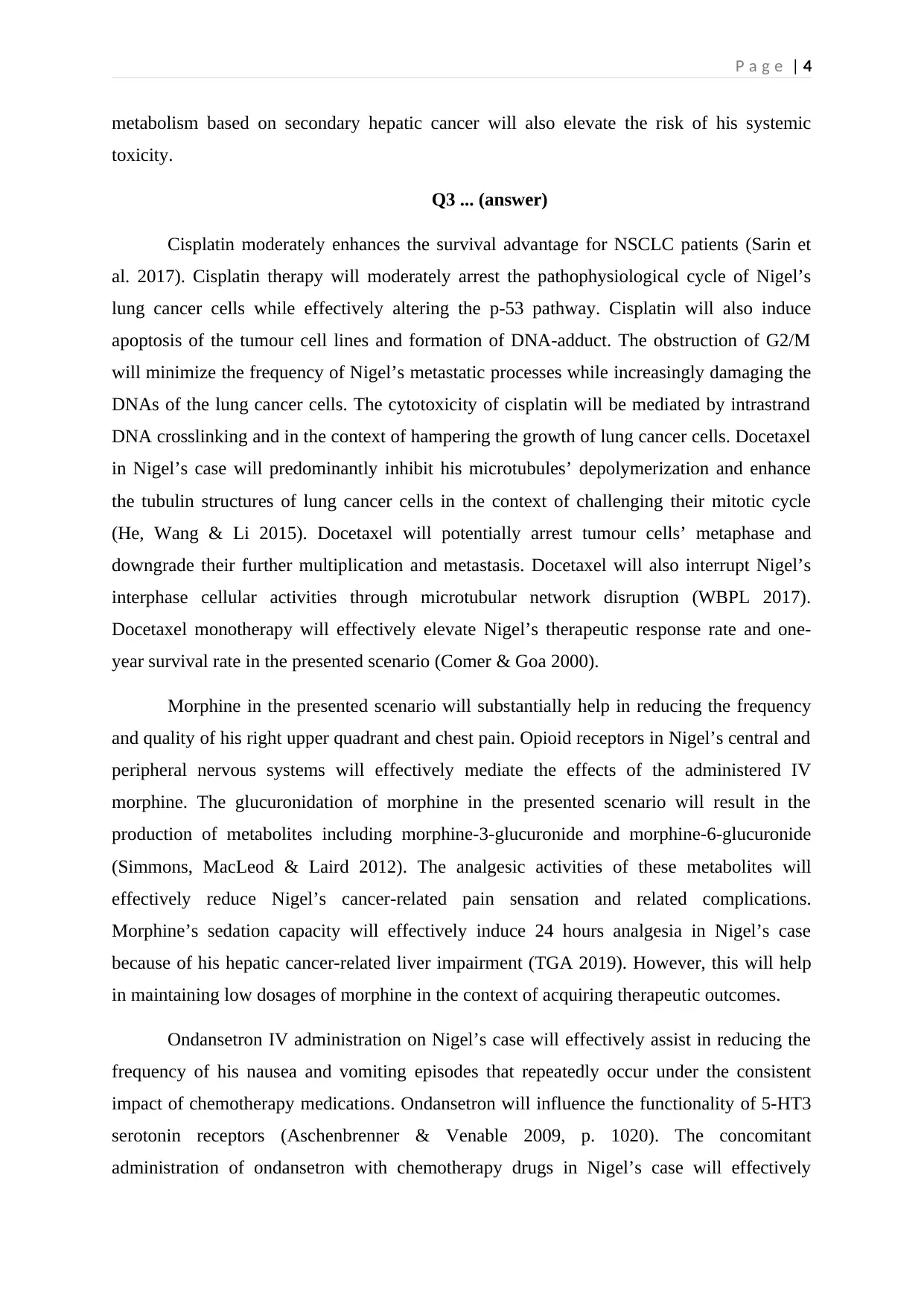
P a g e | 4
metabolism based on secondary hepatic cancer will also elevate the risk of his systemic
toxicity.
Q3 ... (answer)
Cisplatin moderately enhances the survival advantage for NSCLC patients (Sarin et
al. 2017). Cisplatin therapy will moderately arrest the pathophysiological cycle of Nigel’s
lung cancer cells while effectively altering the p-53 pathway. Cisplatin will also induce
apoptosis of the tumour cell lines and formation of DNA-adduct. The obstruction of G2/M
will minimize the frequency of Nigel’s metastatic processes while increasingly damaging the
DNAs of the lung cancer cells. The cytotoxicity of cisplatin will be mediated by intrastrand
DNA crosslinking and in the context of hampering the growth of lung cancer cells. Docetaxel
in Nigel’s case will predominantly inhibit his microtubules’ depolymerization and enhance
the tubulin structures of lung cancer cells in the context of challenging their mitotic cycle
(He, Wang & Li 2015). Docetaxel will potentially arrest tumour cells’ metaphase and
downgrade their further multiplication and metastasis. Docetaxel will also interrupt Nigel’s
interphase cellular activities through microtubular network disruption (WBPL 2017).
Docetaxel monotherapy will effectively elevate Nigel’s therapeutic response rate and one-
year survival rate in the presented scenario (Comer & Goa 2000).
Morphine in the presented scenario will substantially help in reducing the frequency
and quality of his right upper quadrant and chest pain. Opioid receptors in Nigel’s central and
peripheral nervous systems will effectively mediate the effects of the administered IV
morphine. The glucuronidation of morphine in the presented scenario will result in the
production of metabolites including morphine-3-glucuronide and morphine-6-glucuronide
(Simmons, MacLeod & Laird 2012). The analgesic activities of these metabolites will
effectively reduce Nigel’s cancer-related pain sensation and related complications.
Morphine’s sedation capacity will effectively induce 24 hours analgesia in Nigel’s case
because of his hepatic cancer-related liver impairment (TGA 2019). However, this will help
in maintaining low dosages of morphine in the context of acquiring therapeutic outcomes.
Ondansetron IV administration on Nigel’s case will effectively assist in reducing the
frequency of his nausea and vomiting episodes that repeatedly occur under the consistent
impact of chemotherapy medications. Ondansetron will influence the functionality of 5-HT3
serotonin receptors (Aschenbrenner & Venable 2009, p. 1020). The concomitant
administration of ondansetron with chemotherapy drugs in Nigel’s case will effectively
metabolism based on secondary hepatic cancer will also elevate the risk of his systemic
toxicity.
Q3 ... (answer)
Cisplatin moderately enhances the survival advantage for NSCLC patients (Sarin et
al. 2017). Cisplatin therapy will moderately arrest the pathophysiological cycle of Nigel’s
lung cancer cells while effectively altering the p-53 pathway. Cisplatin will also induce
apoptosis of the tumour cell lines and formation of DNA-adduct. The obstruction of G2/M
will minimize the frequency of Nigel’s metastatic processes while increasingly damaging the
DNAs of the lung cancer cells. The cytotoxicity of cisplatin will be mediated by intrastrand
DNA crosslinking and in the context of hampering the growth of lung cancer cells. Docetaxel
in Nigel’s case will predominantly inhibit his microtubules’ depolymerization and enhance
the tubulin structures of lung cancer cells in the context of challenging their mitotic cycle
(He, Wang & Li 2015). Docetaxel will potentially arrest tumour cells’ metaphase and
downgrade their further multiplication and metastasis. Docetaxel will also interrupt Nigel’s
interphase cellular activities through microtubular network disruption (WBPL 2017).
Docetaxel monotherapy will effectively elevate Nigel’s therapeutic response rate and one-
year survival rate in the presented scenario (Comer & Goa 2000).
Morphine in the presented scenario will substantially help in reducing the frequency
and quality of his right upper quadrant and chest pain. Opioid receptors in Nigel’s central and
peripheral nervous systems will effectively mediate the effects of the administered IV
morphine. The glucuronidation of morphine in the presented scenario will result in the
production of metabolites including morphine-3-glucuronide and morphine-6-glucuronide
(Simmons, MacLeod & Laird 2012). The analgesic activities of these metabolites will
effectively reduce Nigel’s cancer-related pain sensation and related complications.
Morphine’s sedation capacity will effectively induce 24 hours analgesia in Nigel’s case
because of his hepatic cancer-related liver impairment (TGA 2019). However, this will help
in maintaining low dosages of morphine in the context of acquiring therapeutic outcomes.
Ondansetron IV administration on Nigel’s case will effectively assist in reducing the
frequency of his nausea and vomiting episodes that repeatedly occur under the consistent
impact of chemotherapy medications. Ondansetron will influence the functionality of 5-HT3
serotonin receptors (Aschenbrenner & Venable 2009, p. 1020). The concomitant
administration of ondansetron with chemotherapy drugs in Nigel’s case will effectively
Secure Best Marks with AI Grader
Need help grading? Try our AI Grader for instant feedback on your assignments.
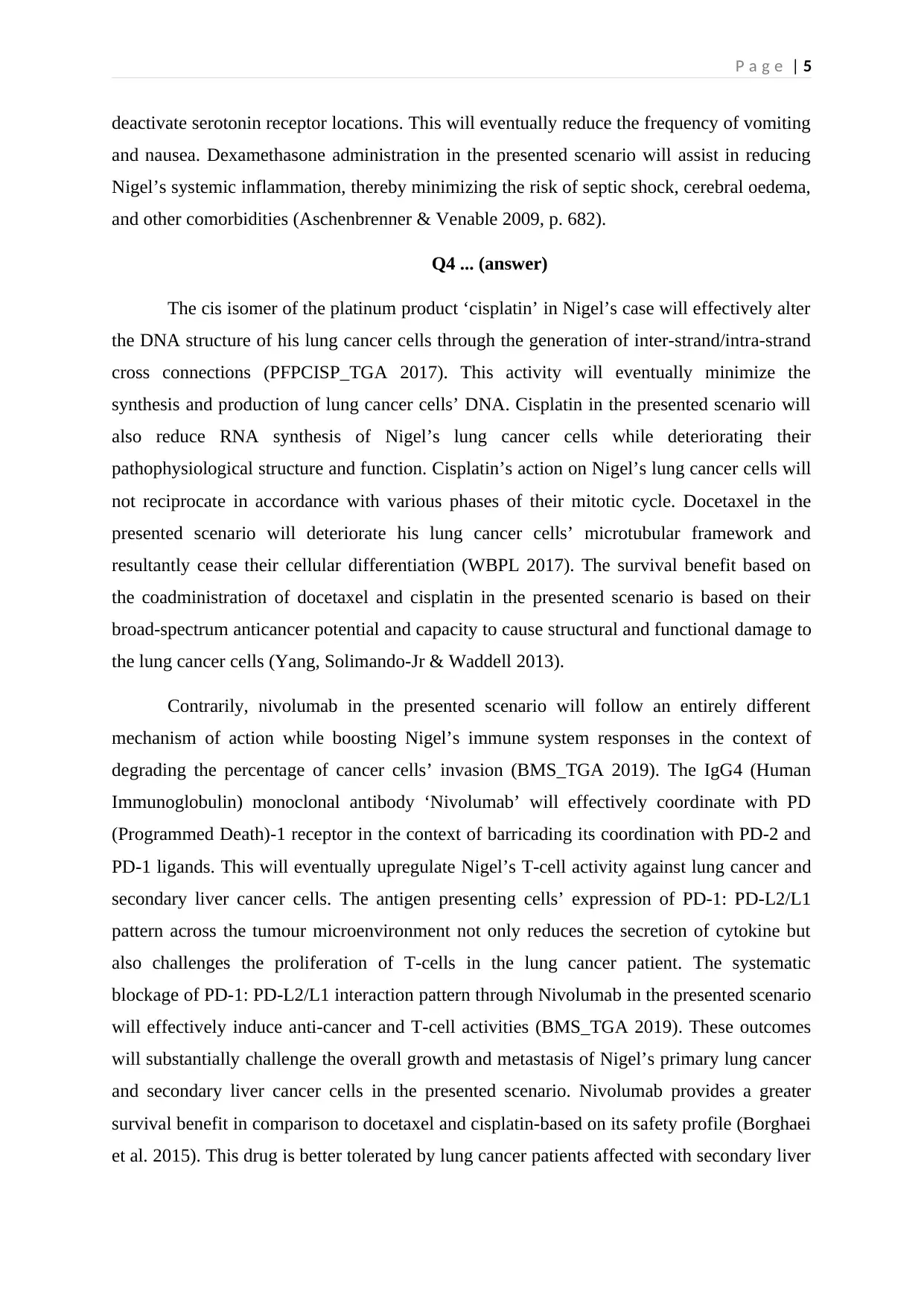
P a g e | 5
deactivate serotonin receptor locations. This will eventually reduce the frequency of vomiting
and nausea. Dexamethasone administration in the presented scenario will assist in reducing
Nigel’s systemic inflammation, thereby minimizing the risk of septic shock, cerebral oedema,
and other comorbidities (Aschenbrenner & Venable 2009, p. 682).
Q4 ... (answer)
The cis isomer of the platinum product ‘cisplatin’ in Nigel’s case will effectively alter
the DNA structure of his lung cancer cells through the generation of inter-strand/intra-strand
cross connections (PFPCISP_TGA 2017). This activity will eventually minimize the
synthesis and production of lung cancer cells’ DNA. Cisplatin in the presented scenario will
also reduce RNA synthesis of Nigel’s lung cancer cells while deteriorating their
pathophysiological structure and function. Cisplatin’s action on Nigel’s lung cancer cells will
not reciprocate in accordance with various phases of their mitotic cycle. Docetaxel in the
presented scenario will deteriorate his lung cancer cells’ microtubular framework and
resultantly cease their cellular differentiation (WBPL 2017). The survival benefit based on
the coadministration of docetaxel and cisplatin in the presented scenario is based on their
broad-spectrum anticancer potential and capacity to cause structural and functional damage to
the lung cancer cells (Yang, Solimando-Jr & Waddell 2013).
Contrarily, nivolumab in the presented scenario will follow an entirely different
mechanism of action while boosting Nigel’s immune system responses in the context of
degrading the percentage of cancer cells’ invasion (BMS_TGA 2019). The IgG4 (Human
Immunoglobulin) monoclonal antibody ‘Nivolumab’ will effectively coordinate with PD
(Programmed Death)-1 receptor in the context of barricading its coordination with PD-2 and
PD-1 ligands. This will eventually upregulate Nigel’s T-cell activity against lung cancer and
secondary liver cancer cells. The antigen presenting cells’ expression of PD-1: PD-L2/L1
pattern across the tumour microenvironment not only reduces the secretion of cytokine but
also challenges the proliferation of T-cells in the lung cancer patient. The systematic
blockage of PD-1: PD-L2/L1 interaction pattern through Nivolumab in the presented scenario
will effectively induce anti-cancer and T-cell activities (BMS_TGA 2019). These outcomes
will substantially challenge the overall growth and metastasis of Nigel’s primary lung cancer
and secondary liver cancer cells in the presented scenario. Nivolumab provides a greater
survival benefit in comparison to docetaxel and cisplatin-based on its safety profile (Borghaei
et al. 2015). This drug is better tolerated by lung cancer patients affected with secondary liver
deactivate serotonin receptor locations. This will eventually reduce the frequency of vomiting
and nausea. Dexamethasone administration in the presented scenario will assist in reducing
Nigel’s systemic inflammation, thereby minimizing the risk of septic shock, cerebral oedema,
and other comorbidities (Aschenbrenner & Venable 2009, p. 682).
Q4 ... (answer)
The cis isomer of the platinum product ‘cisplatin’ in Nigel’s case will effectively alter
the DNA structure of his lung cancer cells through the generation of inter-strand/intra-strand
cross connections (PFPCISP_TGA 2017). This activity will eventually minimize the
synthesis and production of lung cancer cells’ DNA. Cisplatin in the presented scenario will
also reduce RNA synthesis of Nigel’s lung cancer cells while deteriorating their
pathophysiological structure and function. Cisplatin’s action on Nigel’s lung cancer cells will
not reciprocate in accordance with various phases of their mitotic cycle. Docetaxel in the
presented scenario will deteriorate his lung cancer cells’ microtubular framework and
resultantly cease their cellular differentiation (WBPL 2017). The survival benefit based on
the coadministration of docetaxel and cisplatin in the presented scenario is based on their
broad-spectrum anticancer potential and capacity to cause structural and functional damage to
the lung cancer cells (Yang, Solimando-Jr & Waddell 2013).
Contrarily, nivolumab in the presented scenario will follow an entirely different
mechanism of action while boosting Nigel’s immune system responses in the context of
degrading the percentage of cancer cells’ invasion (BMS_TGA 2019). The IgG4 (Human
Immunoglobulin) monoclonal antibody ‘Nivolumab’ will effectively coordinate with PD
(Programmed Death)-1 receptor in the context of barricading its coordination with PD-2 and
PD-1 ligands. This will eventually upregulate Nigel’s T-cell activity against lung cancer and
secondary liver cancer cells. The antigen presenting cells’ expression of PD-1: PD-L2/L1
pattern across the tumour microenvironment not only reduces the secretion of cytokine but
also challenges the proliferation of T-cells in the lung cancer patient. The systematic
blockage of PD-1: PD-L2/L1 interaction pattern through Nivolumab in the presented scenario
will effectively induce anti-cancer and T-cell activities (BMS_TGA 2019). These outcomes
will substantially challenge the overall growth and metastasis of Nigel’s primary lung cancer
and secondary liver cancer cells in the presented scenario. Nivolumab provides a greater
survival benefit in comparison to docetaxel and cisplatin-based on its safety profile (Borghaei
et al. 2015). This drug is better tolerated by lung cancer patients affected with secondary liver

P a g e | 6
cancer and related hepatobiliary complications. Nivolumab’s pharmacotherapeutic actions on
lung cancer cells are based on the context of combination chemotherapy or monotherapy
(Ueno et al. 2019).
Q5 ... (answer)
CINV (Chemotherapy-induced nausea and vomiting) are based on a range of potential
risk factors including gender, age, alcoholism, motion sickness, anxiety, and poorly managed
vomiting/nausea during prior chemotherapy (Schnell 2002). Nigel’s old age in the presented
case study proves to be the biggest factor for his nausea. Chemotherapy for cancer patients
leads to the development of gastrointestinal mucositis that resultantly induces nausea and
vomiting in treated patients (Yamamoto et al. 2013). CINV is classified into anticipatory,
delayed, and acute types based on their duration of occurrence (Hesketh 2019). The vomiting
episode and nausea sensation are the protective reflexes that emanate in cancer patients after
chemotherapy for eliminating toxic elements from their stomach and intestine or
gastrointestinal tract. Nausea is a subjective feeling that cancer patients prevalently
experience while receiving various chemotherapy drugs based on their clinical complications.
Accordingly, Nigel could have subjectively experienced nausea in the context of defected
hepatic first-pass metabolism and elevated drug toxicity. Nausea is a prodromal manifestation
that consistently impacts Nigel before the initiation of his vomiting episode (Navari &
Rapoport 2016, pp. 9-12).
The actual mechanisms of chemotherapy-induced vomiting and nausea are yet
unknown. However, little knowledge in this regard is based on the impact of chemotherapy
drugs on medulla oblongata and cerebral cortex in the context of vagus nerve based small
intestinal stimulation (Navari & Rapoport 2016, pp. 9-12). The cerebral cortex,
gastrointestinal tract’s vagal efferent fibres, pharynx, and chemoreceptor induction area under
the sustained impact of chemotherapy drugs trigger afferent impulses that directly approach
medulla’s lateral reticular formation or vomiting centre for the prompt induction of
nausea/vomiting episodes (Navari & Rapoport 2016, pp. 9-12). These pathophysiological
could have causes Nigel’s nausea and vomiting the presented case study. Chemotherapy
drugs (including Nivolumab, docetaxel, and cisplatin) predominantly deteriorate
gastrointestinal tract’s enterochromaffin cells that eventually induces serotonin production
(Navari & Rapoport 2016, pp. 9-12). The bowel wall’s vagal afferent receptors resultantly
interact with serotonin and transmit afferent impulses to brain’s central pattern generator that
cancer and related hepatobiliary complications. Nivolumab’s pharmacotherapeutic actions on
lung cancer cells are based on the context of combination chemotherapy or monotherapy
(Ueno et al. 2019).
Q5 ... (answer)
CINV (Chemotherapy-induced nausea and vomiting) are based on a range of potential
risk factors including gender, age, alcoholism, motion sickness, anxiety, and poorly managed
vomiting/nausea during prior chemotherapy (Schnell 2002). Nigel’s old age in the presented
case study proves to be the biggest factor for his nausea. Chemotherapy for cancer patients
leads to the development of gastrointestinal mucositis that resultantly induces nausea and
vomiting in treated patients (Yamamoto et al. 2013). CINV is classified into anticipatory,
delayed, and acute types based on their duration of occurrence (Hesketh 2019). The vomiting
episode and nausea sensation are the protective reflexes that emanate in cancer patients after
chemotherapy for eliminating toxic elements from their stomach and intestine or
gastrointestinal tract. Nausea is a subjective feeling that cancer patients prevalently
experience while receiving various chemotherapy drugs based on their clinical complications.
Accordingly, Nigel could have subjectively experienced nausea in the context of defected
hepatic first-pass metabolism and elevated drug toxicity. Nausea is a prodromal manifestation
that consistently impacts Nigel before the initiation of his vomiting episode (Navari &
Rapoport 2016, pp. 9-12).
The actual mechanisms of chemotherapy-induced vomiting and nausea are yet
unknown. However, little knowledge in this regard is based on the impact of chemotherapy
drugs on medulla oblongata and cerebral cortex in the context of vagus nerve based small
intestinal stimulation (Navari & Rapoport 2016, pp. 9-12). The cerebral cortex,
gastrointestinal tract’s vagal efferent fibres, pharynx, and chemoreceptor induction area under
the sustained impact of chemotherapy drugs trigger afferent impulses that directly approach
medulla’s lateral reticular formation or vomiting centre for the prompt induction of
nausea/vomiting episodes (Navari & Rapoport 2016, pp. 9-12). These pathophysiological
could have causes Nigel’s nausea and vomiting the presented case study. Chemotherapy
drugs (including Nivolumab, docetaxel, and cisplatin) predominantly deteriorate
gastrointestinal tract’s enterochromaffin cells that eventually induces serotonin production
(Navari & Rapoport 2016, pp. 9-12). The bowel wall’s vagal afferent receptors resultantly
interact with serotonin and transmit afferent impulses to brain’s central pattern generator that
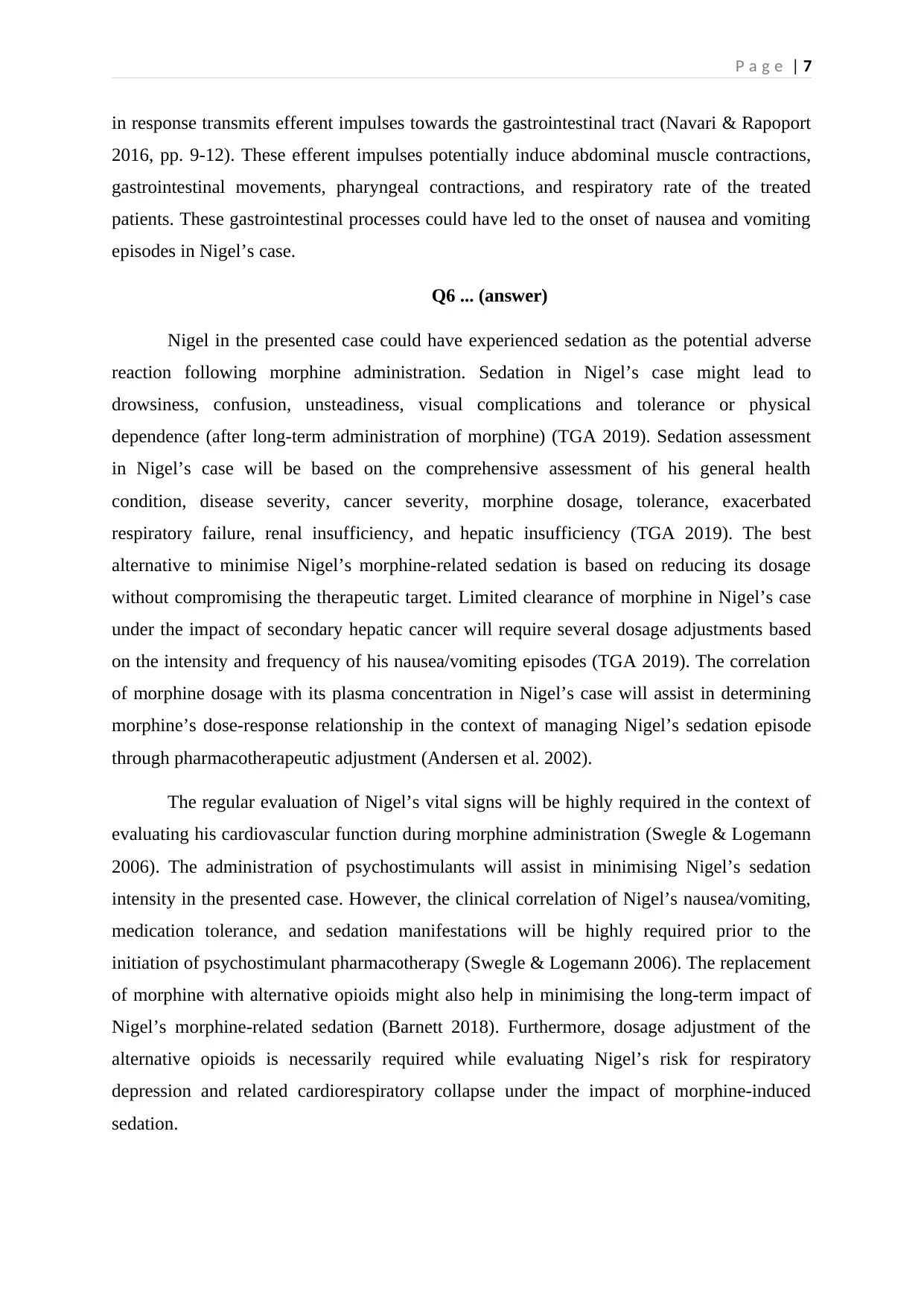
P a g e | 7
in response transmits efferent impulses towards the gastrointestinal tract (Navari & Rapoport
2016, pp. 9-12). These efferent impulses potentially induce abdominal muscle contractions,
gastrointestinal movements, pharyngeal contractions, and respiratory rate of the treated
patients. These gastrointestinal processes could have led to the onset of nausea and vomiting
episodes in Nigel’s case.
Q6 ... (answer)
Nigel in the presented case could have experienced sedation as the potential adverse
reaction following morphine administration. Sedation in Nigel’s case might lead to
drowsiness, confusion, unsteadiness, visual complications and tolerance or physical
dependence (after long-term administration of morphine) (TGA 2019). Sedation assessment
in Nigel’s case will be based on the comprehensive assessment of his general health
condition, disease severity, cancer severity, morphine dosage, tolerance, exacerbated
respiratory failure, renal insufficiency, and hepatic insufficiency (TGA 2019). The best
alternative to minimise Nigel’s morphine-related sedation is based on reducing its dosage
without compromising the therapeutic target. Limited clearance of morphine in Nigel’s case
under the impact of secondary hepatic cancer will require several dosage adjustments based
on the intensity and frequency of his nausea/vomiting episodes (TGA 2019). The correlation
of morphine dosage with its plasma concentration in Nigel’s case will assist in determining
morphine’s dose-response relationship in the context of managing Nigel’s sedation episode
through pharmacotherapeutic adjustment (Andersen et al. 2002).
The regular evaluation of Nigel’s vital signs will be highly required in the context of
evaluating his cardiovascular function during morphine administration (Swegle & Logemann
2006). The administration of psychostimulants will assist in minimising Nigel’s sedation
intensity in the presented case. However, the clinical correlation of Nigel’s nausea/vomiting,
medication tolerance, and sedation manifestations will be highly required prior to the
initiation of psychostimulant pharmacotherapy (Swegle & Logemann 2006). The replacement
of morphine with alternative opioids might also help in minimising the long-term impact of
Nigel’s morphine-related sedation (Barnett 2018). Furthermore, dosage adjustment of the
alternative opioids is necessarily required while evaluating Nigel’s risk for respiratory
depression and related cardiorespiratory collapse under the impact of morphine-induced
sedation.
in response transmits efferent impulses towards the gastrointestinal tract (Navari & Rapoport
2016, pp. 9-12). These efferent impulses potentially induce abdominal muscle contractions,
gastrointestinal movements, pharyngeal contractions, and respiratory rate of the treated
patients. These gastrointestinal processes could have led to the onset of nausea and vomiting
episodes in Nigel’s case.
Q6 ... (answer)
Nigel in the presented case could have experienced sedation as the potential adverse
reaction following morphine administration. Sedation in Nigel’s case might lead to
drowsiness, confusion, unsteadiness, visual complications and tolerance or physical
dependence (after long-term administration of morphine) (TGA 2019). Sedation assessment
in Nigel’s case will be based on the comprehensive assessment of his general health
condition, disease severity, cancer severity, morphine dosage, tolerance, exacerbated
respiratory failure, renal insufficiency, and hepatic insufficiency (TGA 2019). The best
alternative to minimise Nigel’s morphine-related sedation is based on reducing its dosage
without compromising the therapeutic target. Limited clearance of morphine in Nigel’s case
under the impact of secondary hepatic cancer will require several dosage adjustments based
on the intensity and frequency of his nausea/vomiting episodes (TGA 2019). The correlation
of morphine dosage with its plasma concentration in Nigel’s case will assist in determining
morphine’s dose-response relationship in the context of managing Nigel’s sedation episode
through pharmacotherapeutic adjustment (Andersen et al. 2002).
The regular evaluation of Nigel’s vital signs will be highly required in the context of
evaluating his cardiovascular function during morphine administration (Swegle & Logemann
2006). The administration of psychostimulants will assist in minimising Nigel’s sedation
intensity in the presented case. However, the clinical correlation of Nigel’s nausea/vomiting,
medication tolerance, and sedation manifestations will be highly required prior to the
initiation of psychostimulant pharmacotherapy (Swegle & Logemann 2006). The replacement
of morphine with alternative opioids might also help in minimising the long-term impact of
Nigel’s morphine-related sedation (Barnett 2018). Furthermore, dosage adjustment of the
alternative opioids is necessarily required while evaluating Nigel’s risk for respiratory
depression and related cardiorespiratory collapse under the impact of morphine-induced
sedation.
Paraphrase This Document
Need a fresh take? Get an instant paraphrase of this document with our AI Paraphraser
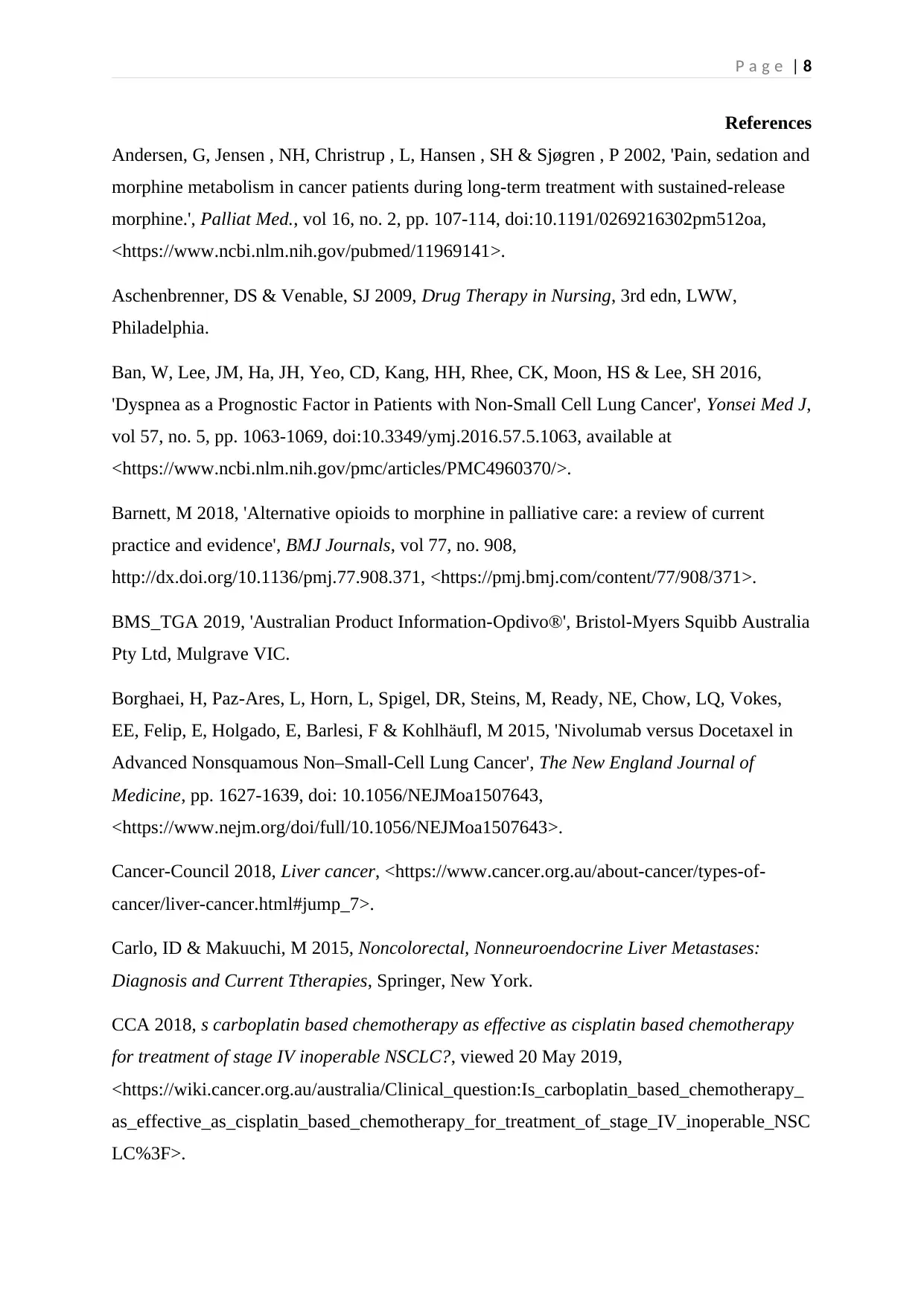
P a g e | 8
References
Andersen, G, Jensen , NH, Christrup , L, Hansen , SH & Sjøgren , P 2002, 'Pain, sedation and
morphine metabolism in cancer patients during long-term treatment with sustained-release
morphine.', Palliat Med., vol 16, no. 2, pp. 107-114, doi:10.1191/0269216302pm512oa,
<https://www.ncbi.nlm.nih.gov/pubmed/11969141>.
Aschenbrenner, DS & Venable, SJ 2009, Drug Therapy in Nursing, 3rd edn, LWW,
Philadelphia.
Ban, W, Lee, JM, Ha, JH, Yeo, CD, Kang, HH, Rhee, CK, Moon, HS & Lee, SH 2016,
'Dyspnea as a Prognostic Factor in Patients with Non-Small Cell Lung Cancer', Yonsei Med J,
vol 57, no. 5, pp. 1063-1069, doi:10.3349/ymj.2016.57.5.1063, available at
<https://www.ncbi.nlm.nih.gov/pmc/articles/PMC4960370/>.
Barnett, M 2018, 'Alternative opioids to morphine in palliative care: a review of current
practice and evidence', BMJ Journals, vol 77, no. 908,
http://dx.doi.org/10.1136/pmj.77.908.371, <https://pmj.bmj.com/content/77/908/371>.
BMS_TGA 2019, 'Australian Product Information-Opdivo®', Bristol-Myers Squibb Australia
Pty Ltd, Mulgrave VIC.
Borghaei, H, Paz-Ares, L, Horn, L, Spigel, DR, Steins, M, Ready, NE, Chow, LQ, Vokes,
EE, Felip, E, Holgado, E, Barlesi, F & Kohlhäufl, M 2015, 'Nivolumab versus Docetaxel in
Advanced Nonsquamous Non–Small-Cell Lung Cancer', The New England Journal of
Medicine, pp. 1627-1639, doi: 10.1056/NEJMoa1507643,
<https://www.nejm.org/doi/full/10.1056/NEJMoa1507643>.
Cancer-Council 2018, Liver cancer, <https://www.cancer.org.au/about-cancer/types-of-
cancer/liver-cancer.html#jump_7>.
Carlo, ID & Makuuchi, M 2015, Noncolorectal, Nonneuroendocrine Liver Metastases:
Diagnosis and Current Ttherapies, Springer, New York.
CCA 2018, s carboplatin based chemotherapy as effective as cisplatin based chemotherapy
for treatment of stage IV inoperable NSCLC?, viewed 20 May 2019,
<https://wiki.cancer.org.au/australia/Clinical_question:Is_carboplatin_based_chemotherapy_
as_effective_as_cisplatin_based_chemotherapy_for_treatment_of_stage_IV_inoperable_NSC
LC%3F>.
References
Andersen, G, Jensen , NH, Christrup , L, Hansen , SH & Sjøgren , P 2002, 'Pain, sedation and
morphine metabolism in cancer patients during long-term treatment with sustained-release
morphine.', Palliat Med., vol 16, no. 2, pp. 107-114, doi:10.1191/0269216302pm512oa,
<https://www.ncbi.nlm.nih.gov/pubmed/11969141>.
Aschenbrenner, DS & Venable, SJ 2009, Drug Therapy in Nursing, 3rd edn, LWW,
Philadelphia.
Ban, W, Lee, JM, Ha, JH, Yeo, CD, Kang, HH, Rhee, CK, Moon, HS & Lee, SH 2016,
'Dyspnea as a Prognostic Factor in Patients with Non-Small Cell Lung Cancer', Yonsei Med J,
vol 57, no. 5, pp. 1063-1069, doi:10.3349/ymj.2016.57.5.1063, available at
<https://www.ncbi.nlm.nih.gov/pmc/articles/PMC4960370/>.
Barnett, M 2018, 'Alternative opioids to morphine in palliative care: a review of current
practice and evidence', BMJ Journals, vol 77, no. 908,
http://dx.doi.org/10.1136/pmj.77.908.371, <https://pmj.bmj.com/content/77/908/371>.
BMS_TGA 2019, 'Australian Product Information-Opdivo®', Bristol-Myers Squibb Australia
Pty Ltd, Mulgrave VIC.
Borghaei, H, Paz-Ares, L, Horn, L, Spigel, DR, Steins, M, Ready, NE, Chow, LQ, Vokes,
EE, Felip, E, Holgado, E, Barlesi, F & Kohlhäufl, M 2015, 'Nivolumab versus Docetaxel in
Advanced Nonsquamous Non–Small-Cell Lung Cancer', The New England Journal of
Medicine, pp. 1627-1639, doi: 10.1056/NEJMoa1507643,
<https://www.nejm.org/doi/full/10.1056/NEJMoa1507643>.
Cancer-Council 2018, Liver cancer, <https://www.cancer.org.au/about-cancer/types-of-
cancer/liver-cancer.html#jump_7>.
Carlo, ID & Makuuchi, M 2015, Noncolorectal, Nonneuroendocrine Liver Metastases:
Diagnosis and Current Ttherapies, Springer, New York.
CCA 2018, s carboplatin based chemotherapy as effective as cisplatin based chemotherapy
for treatment of stage IV inoperable NSCLC?, viewed 20 May 2019,
<https://wiki.cancer.org.au/australia/Clinical_question:Is_carboplatin_based_chemotherapy_
as_effective_as_cisplatin_based_chemotherapy_for_treatment_of_stage_IV_inoperable_NSC
LC%3F>.
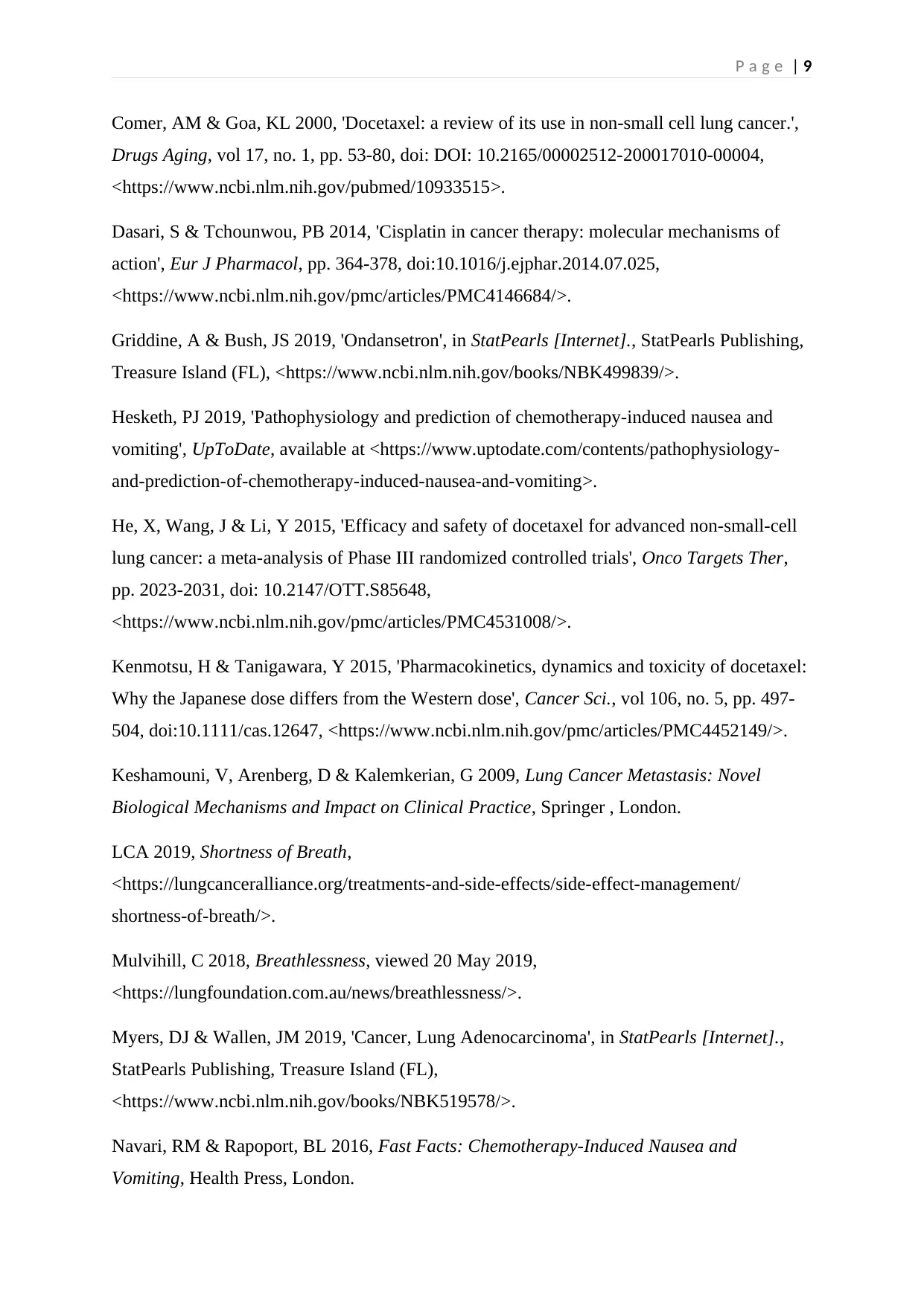
P a g e | 9
Comer, AM & Goa, KL 2000, 'Docetaxel: a review of its use in non-small cell lung cancer.',
Drugs Aging, vol 17, no. 1, pp. 53-80, doi: DOI: 10.2165/00002512-200017010-00004,
<https://www.ncbi.nlm.nih.gov/pubmed/10933515>.
Dasari, S & Tchounwou, PB 2014, 'Cisplatin in cancer therapy: molecular mechanisms of
action', Eur J Pharmacol, pp. 364-378, doi:10.1016/j.ejphar.2014.07.025,
<https://www.ncbi.nlm.nih.gov/pmc/articles/PMC4146684/>.
Griddine, A & Bush, JS 2019, 'Ondansetron', in StatPearls [Internet]., StatPearls Publishing,
Treasure Island (FL), <https://www.ncbi.nlm.nih.gov/books/NBK499839/>.
Hesketh, PJ 2019, 'Pathophysiology and prediction of chemotherapy-induced nausea and
vomiting', UpToDate, available at <https://www.uptodate.com/contents/pathophysiology-
and-prediction-of-chemotherapy-induced-nausea-and-vomiting>.
He, X, Wang, J & Li, Y 2015, 'Efficacy and safety of docetaxel for advanced non-small-cell
lung cancer: a meta-analysis of Phase III randomized controlled trials', Onco Targets Ther,
pp. 2023-2031, doi: 10.2147/OTT.S85648,
<https://www.ncbi.nlm.nih.gov/pmc/articles/PMC4531008/>.
Kenmotsu, H & Tanigawara, Y 2015, 'Pharmacokinetics, dynamics and toxicity of docetaxel:
Why the Japanese dose differs from the Western dose', Cancer Sci., vol 106, no. 5, pp. 497-
504, doi:10.1111/cas.12647, <https://www.ncbi.nlm.nih.gov/pmc/articles/PMC4452149/>.
Keshamouni, V, Arenberg, D & Kalemkerian, G 2009, Lung Cancer Metastasis: Novel
Biological Mechanisms and Impact on Clinical Practice, Springer , London.
LCA 2019, Shortness of Breath,
<https://lungcanceralliance.org/treatments-and-side-effects/side-effect-management/
shortness-of-breath/>.
Mulvihill, C 2018, Breathlessness, viewed 20 May 2019,
<https://lungfoundation.com.au/news/breathlessness/>.
Myers, DJ & Wallen, JM 2019, 'Cancer, Lung Adenocarcinoma', in StatPearls [Internet].,
StatPearls Publishing, Treasure Island (FL),
<https://www.ncbi.nlm.nih.gov/books/NBK519578/>.
Navari, RM & Rapoport, BL 2016, Fast Facts: Chemotherapy-Induced Nausea and
Vomiting, Health Press, London.
Comer, AM & Goa, KL 2000, 'Docetaxel: a review of its use in non-small cell lung cancer.',
Drugs Aging, vol 17, no. 1, pp. 53-80, doi: DOI: 10.2165/00002512-200017010-00004,
<https://www.ncbi.nlm.nih.gov/pubmed/10933515>.
Dasari, S & Tchounwou, PB 2014, 'Cisplatin in cancer therapy: molecular mechanisms of
action', Eur J Pharmacol, pp. 364-378, doi:10.1016/j.ejphar.2014.07.025,
<https://www.ncbi.nlm.nih.gov/pmc/articles/PMC4146684/>.
Griddine, A & Bush, JS 2019, 'Ondansetron', in StatPearls [Internet]., StatPearls Publishing,
Treasure Island (FL), <https://www.ncbi.nlm.nih.gov/books/NBK499839/>.
Hesketh, PJ 2019, 'Pathophysiology and prediction of chemotherapy-induced nausea and
vomiting', UpToDate, available at <https://www.uptodate.com/contents/pathophysiology-
and-prediction-of-chemotherapy-induced-nausea-and-vomiting>.
He, X, Wang, J & Li, Y 2015, 'Efficacy and safety of docetaxel for advanced non-small-cell
lung cancer: a meta-analysis of Phase III randomized controlled trials', Onco Targets Ther,
pp. 2023-2031, doi: 10.2147/OTT.S85648,
<https://www.ncbi.nlm.nih.gov/pmc/articles/PMC4531008/>.
Kenmotsu, H & Tanigawara, Y 2015, 'Pharmacokinetics, dynamics and toxicity of docetaxel:
Why the Japanese dose differs from the Western dose', Cancer Sci., vol 106, no. 5, pp. 497-
504, doi:10.1111/cas.12647, <https://www.ncbi.nlm.nih.gov/pmc/articles/PMC4452149/>.
Keshamouni, V, Arenberg, D & Kalemkerian, G 2009, Lung Cancer Metastasis: Novel
Biological Mechanisms and Impact on Clinical Practice, Springer , London.
LCA 2019, Shortness of Breath,
<https://lungcanceralliance.org/treatments-and-side-effects/side-effect-management/
shortness-of-breath/>.
Mulvihill, C 2018, Breathlessness, viewed 20 May 2019,
<https://lungfoundation.com.au/news/breathlessness/>.
Myers, DJ & Wallen, JM 2019, 'Cancer, Lung Adenocarcinoma', in StatPearls [Internet].,
StatPearls Publishing, Treasure Island (FL),
<https://www.ncbi.nlm.nih.gov/books/NBK519578/>.
Navari, RM & Rapoport, BL 2016, Fast Facts: Chemotherapy-Induced Nausea and
Vomiting, Health Press, London.

P a g e | 10
PFPCISP_TGA 2017, 'CISPLATIN INJECTION', Pfizer Australia Pty Ltd, West Ryde NSW.
Philip, J, Hudson, P, Bostanci, A, Street, A, Horey, DE, Aranda, S, Zordan, R, Rumbold, BD,
Moore, G & Sundararajan, V 2015, 'Metastatic non-small cell lung cancer: a benchmark for
quality end-of-life cancer care?', MJA, vol 202, no. 3, pp. 139-143, doi:
10.5694/mja14.00579, available at <https://www.mja.com.au/journal/2015/202/3/metastatic-
non-small-cell-lung-cancer-benchmark-quality-end-life-cancer-care>.
Ren, Y, Dai, C, Zheng, H, Zhou, F, She, Y, Jiang, G, Fei, G, Yang, P, Xie, D & Chen, C
2016, 'Prognostic effect of liver metastasis in lung cancer patients with distant metastasis',
Oncotarget., vol 7, no. 33, pp. 53245-53253, 10.18632/oncotarget.10644, available at
<https://www.ncbi.nlm.nih.gov/pmc/articles/PMC5288182/>.
Sarin, N, Engel, F, Kalayda, GV, Mannewitz, M, Cinatl-Jr, J, Rothweiler, F, Michaelis, M,
Saafan, H, Ritter, CA, Jaehde, U & Frötschl, R 2017, 'Cisplatin resistance in non-small cell
lung cancer cells is associated with an abrogation of cisplatin-induced G2/M cell cycle arrest',
PLoS One, pp. 1-26, doi:10.1371/journal.pone.0181081, available at
<https://www.ncbi.nlm.nih.gov/pmc/articles/PMC5528889/>.
Schnell, FM 2002, 'Chemotherapy-Induced Nausea and Vomiting: The Importance of Acute
Antiemetic Control', Tthe Oncologist, available at
<http://theoncologist.alphamedpress.org/content/8/2/187.full>.
Shin, JA, Kosiba, JD, Traeger, L, Greer, JA, Temel, JS & Pirl, WF 2014, 'Dyspnea and Panic
Among Patients With Newly Diagnosed Non-Small Cell Lung Cancer', J Pain Symptom
Manage., vol 48, no. 3, pp. 465-470, doi:10.1016/j.jpainsymman.2013.10.021, available at
<https://www.ncbi.nlm.nih.gov/pmc/articles/PMC4163506/>.
Simmons, CPL, MacLeod, N & Laird, JA 2012, 'Clinical Management of Pain in Advanced
Lung Cancer', Clin Med Insights Oncol., pp. 331-346, 10.4137/CMO.S8360, available at
<https://www.ncbi.nlm.nih.gov/pmc/articles/PMC3474460/>.
Soleimanpour, H, Safari, S, Nia, KS, Sanaie, S & Alavian, SM 2016, 'Opioid Drugs in
Patients With Liver Disease: A Systematic Review', Hepatitis Monthly, vol 4, p. 16,available
at <http://hepatmon.com/en/articles/55414.html>.
Swegle, JM & Logemann, C 2006, 'Management of Common Opioid-Induced Adverse
Effects', American Family Physician, vol 74, no. 8, pp. 1347-1354, available at
PFPCISP_TGA 2017, 'CISPLATIN INJECTION', Pfizer Australia Pty Ltd, West Ryde NSW.
Philip, J, Hudson, P, Bostanci, A, Street, A, Horey, DE, Aranda, S, Zordan, R, Rumbold, BD,
Moore, G & Sundararajan, V 2015, 'Metastatic non-small cell lung cancer: a benchmark for
quality end-of-life cancer care?', MJA, vol 202, no. 3, pp. 139-143, doi:
10.5694/mja14.00579, available at <https://www.mja.com.au/journal/2015/202/3/metastatic-
non-small-cell-lung-cancer-benchmark-quality-end-life-cancer-care>.
Ren, Y, Dai, C, Zheng, H, Zhou, F, She, Y, Jiang, G, Fei, G, Yang, P, Xie, D & Chen, C
2016, 'Prognostic effect of liver metastasis in lung cancer patients with distant metastasis',
Oncotarget., vol 7, no. 33, pp. 53245-53253, 10.18632/oncotarget.10644, available at
<https://www.ncbi.nlm.nih.gov/pmc/articles/PMC5288182/>.
Sarin, N, Engel, F, Kalayda, GV, Mannewitz, M, Cinatl-Jr, J, Rothweiler, F, Michaelis, M,
Saafan, H, Ritter, CA, Jaehde, U & Frötschl, R 2017, 'Cisplatin resistance in non-small cell
lung cancer cells is associated with an abrogation of cisplatin-induced G2/M cell cycle arrest',
PLoS One, pp. 1-26, doi:10.1371/journal.pone.0181081, available at
<https://www.ncbi.nlm.nih.gov/pmc/articles/PMC5528889/>.
Schnell, FM 2002, 'Chemotherapy-Induced Nausea and Vomiting: The Importance of Acute
Antiemetic Control', Tthe Oncologist, available at
<http://theoncologist.alphamedpress.org/content/8/2/187.full>.
Shin, JA, Kosiba, JD, Traeger, L, Greer, JA, Temel, JS & Pirl, WF 2014, 'Dyspnea and Panic
Among Patients With Newly Diagnosed Non-Small Cell Lung Cancer', J Pain Symptom
Manage., vol 48, no. 3, pp. 465-470, doi:10.1016/j.jpainsymman.2013.10.021, available at
<https://www.ncbi.nlm.nih.gov/pmc/articles/PMC4163506/>.
Simmons, CPL, MacLeod, N & Laird, JA 2012, 'Clinical Management of Pain in Advanced
Lung Cancer', Clin Med Insights Oncol., pp. 331-346, 10.4137/CMO.S8360, available at
<https://www.ncbi.nlm.nih.gov/pmc/articles/PMC3474460/>.
Soleimanpour, H, Safari, S, Nia, KS, Sanaie, S & Alavian, SM 2016, 'Opioid Drugs in
Patients With Liver Disease: A Systematic Review', Hepatitis Monthly, vol 4, p. 16,available
at <http://hepatmon.com/en/articles/55414.html>.
Swegle, JM & Logemann, C 2006, 'Management of Common Opioid-Induced Adverse
Effects', American Family Physician, vol 74, no. 8, pp. 1347-1354, available at
Secure Best Marks with AI Grader
Need help grading? Try our AI Grader for instant feedback on your assignments.
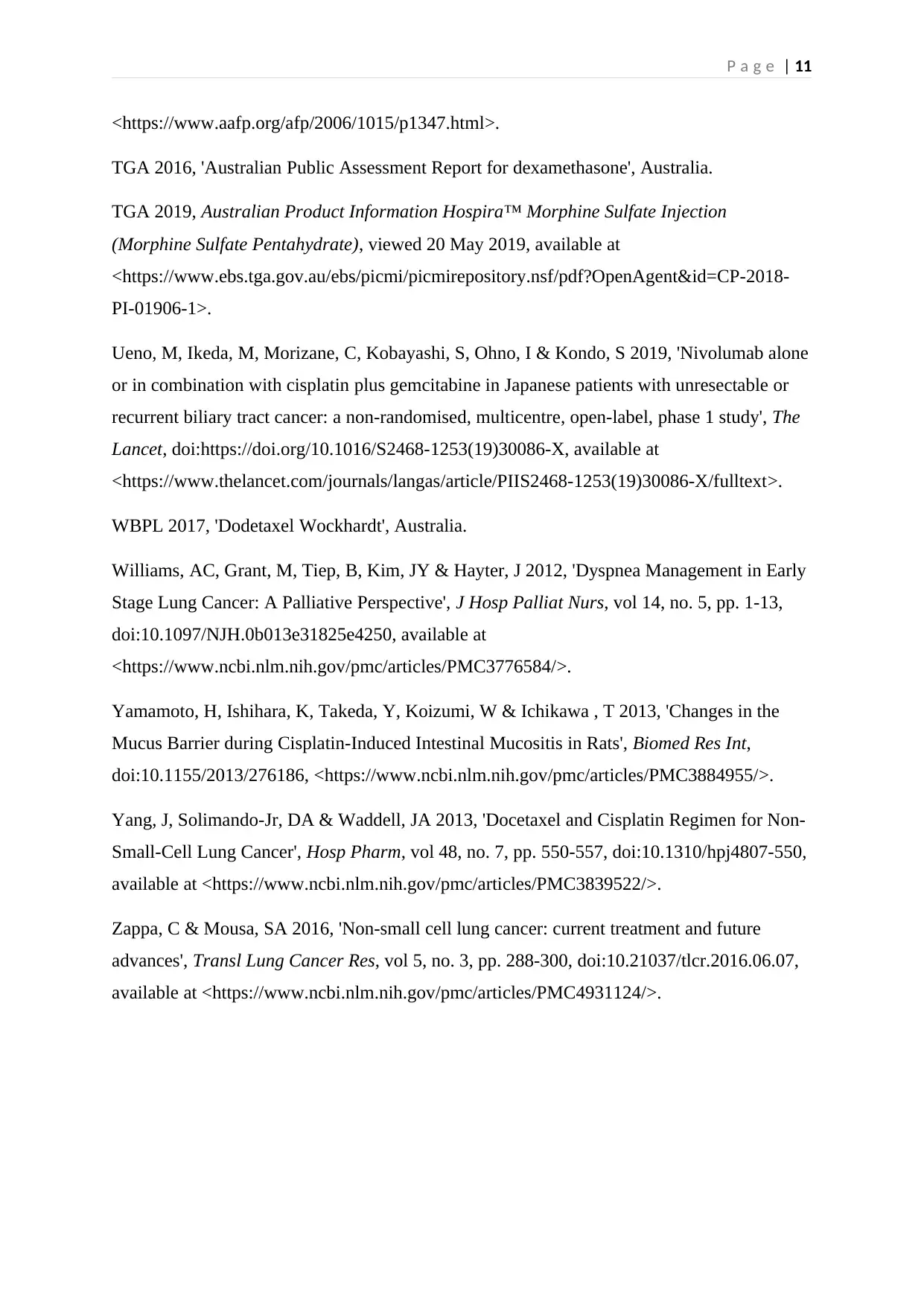
P a g e | 11
<https://www.aafp.org/afp/2006/1015/p1347.html>.
TGA 2016, 'Australian Public Assessment Report for dexamethasone', Australia.
TGA 2019, Australian Product Information Hospira™ Morphine Sulfate Injection
(Morphine Sulfate Pentahydrate), viewed 20 May 2019, available at
<https://www.ebs.tga.gov.au/ebs/picmi/picmirepository.nsf/pdf?OpenAgent&id=CP-2018-
PI-01906-1>.
Ueno, M, Ikeda, M, Morizane, C, Kobayashi, S, Ohno, I & Kondo, S 2019, 'Nivolumab alone
or in combination with cisplatin plus gemcitabine in Japanese patients with unresectable or
recurrent biliary tract cancer: a non-randomised, multicentre, open-label, phase 1 study', The
Lancet, doi:https://doi.org/10.1016/S2468-1253(19)30086-X, available at
<https://www.thelancet.com/journals/langas/article/PIIS2468-1253(19)30086-X/fulltext>.
WBPL 2017, 'Dodetaxel Wockhardt', Australia.
Williams, AC, Grant, M, Tiep, B, Kim, JY & Hayter, J 2012, 'Dyspnea Management in Early
Stage Lung Cancer: A Palliative Perspective', J Hosp Palliat Nurs, vol 14, no. 5, pp. 1-13,
doi:10.1097/NJH.0b013e31825e4250, available at
<https://www.ncbi.nlm.nih.gov/pmc/articles/PMC3776584/>.
Yamamoto, H, Ishihara, K, Takeda, Y, Koizumi, W & Ichikawa , T 2013, 'Changes in the
Mucus Barrier during Cisplatin-Induced Intestinal Mucositis in Rats', Biomed Res Int,
doi:10.1155/2013/276186, <https://www.ncbi.nlm.nih.gov/pmc/articles/PMC3884955/>.
Yang, J, Solimando-Jr, DA & Waddell, JA 2013, 'Docetaxel and Cisplatin Regimen for Non-
Small-Cell Lung Cancer', Hosp Pharm, vol 48, no. 7, pp. 550-557, doi:10.1310/hpj4807-550,
available at <https://www.ncbi.nlm.nih.gov/pmc/articles/PMC3839522/>.
Zappa, C & Mousa, SA 2016, 'Non-small cell lung cancer: current treatment and future
advances', Transl Lung Cancer Res, vol 5, no. 3, pp. 288-300, doi:10.21037/tlcr.2016.06.07,
available at <https://www.ncbi.nlm.nih.gov/pmc/articles/PMC4931124/>.
<https://www.aafp.org/afp/2006/1015/p1347.html>.
TGA 2016, 'Australian Public Assessment Report for dexamethasone', Australia.
TGA 2019, Australian Product Information Hospira™ Morphine Sulfate Injection
(Morphine Sulfate Pentahydrate), viewed 20 May 2019, available at
<https://www.ebs.tga.gov.au/ebs/picmi/picmirepository.nsf/pdf?OpenAgent&id=CP-2018-
PI-01906-1>.
Ueno, M, Ikeda, M, Morizane, C, Kobayashi, S, Ohno, I & Kondo, S 2019, 'Nivolumab alone
or in combination with cisplatin plus gemcitabine in Japanese patients with unresectable or
recurrent biliary tract cancer: a non-randomised, multicentre, open-label, phase 1 study', The
Lancet, doi:https://doi.org/10.1016/S2468-1253(19)30086-X, available at
<https://www.thelancet.com/journals/langas/article/PIIS2468-1253(19)30086-X/fulltext>.
WBPL 2017, 'Dodetaxel Wockhardt', Australia.
Williams, AC, Grant, M, Tiep, B, Kim, JY & Hayter, J 2012, 'Dyspnea Management in Early
Stage Lung Cancer: A Palliative Perspective', J Hosp Palliat Nurs, vol 14, no. 5, pp. 1-13,
doi:10.1097/NJH.0b013e31825e4250, available at
<https://www.ncbi.nlm.nih.gov/pmc/articles/PMC3776584/>.
Yamamoto, H, Ishihara, K, Takeda, Y, Koizumi, W & Ichikawa , T 2013, 'Changes in the
Mucus Barrier during Cisplatin-Induced Intestinal Mucositis in Rats', Biomed Res Int,
doi:10.1155/2013/276186, <https://www.ncbi.nlm.nih.gov/pmc/articles/PMC3884955/>.
Yang, J, Solimando-Jr, DA & Waddell, JA 2013, 'Docetaxel and Cisplatin Regimen for Non-
Small-Cell Lung Cancer', Hosp Pharm, vol 48, no. 7, pp. 550-557, doi:10.1310/hpj4807-550,
available at <https://www.ncbi.nlm.nih.gov/pmc/articles/PMC3839522/>.
Zappa, C & Mousa, SA 2016, 'Non-small cell lung cancer: current treatment and future
advances', Transl Lung Cancer Res, vol 5, no. 3, pp. 288-300, doi:10.21037/tlcr.2016.06.07,
available at <https://www.ncbi.nlm.nih.gov/pmc/articles/PMC4931124/>.
1 out of 11
Related Documents
Your All-in-One AI-Powered Toolkit for Academic Success.
+13062052269
info@desklib.com
Available 24*7 on WhatsApp / Email
![[object Object]](/_next/static/media/star-bottom.7253800d.svg)
Unlock your academic potential
© 2024 | Zucol Services PVT LTD | All rights reserved.




